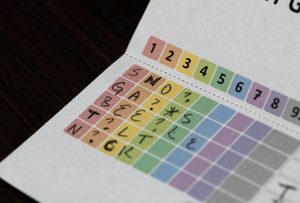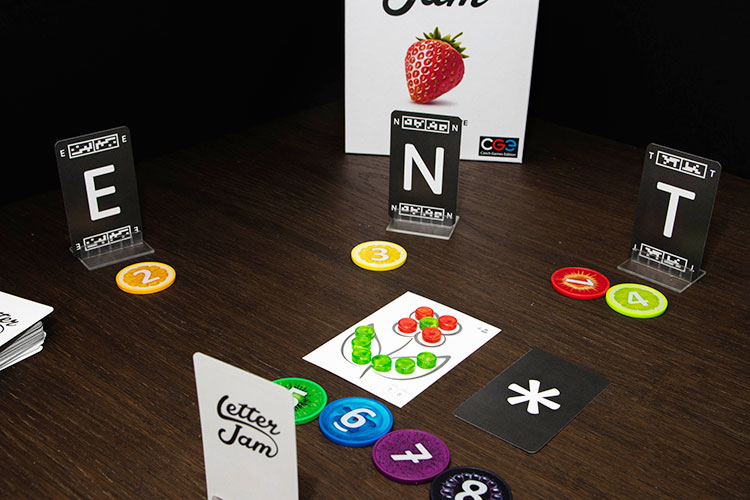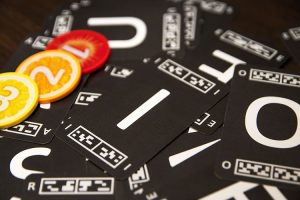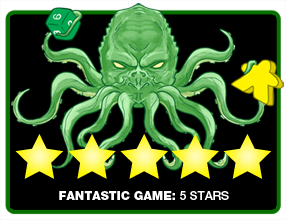 When I first heard about Letter Jam it was described as a Hanabi-style word game. Now, I hate Hanabi. But it’s mostly because the memory aspect is incredibly frustrating and the idea of putting cards down in a particular order isn’t super exciting to me.
When I first heard about Letter Jam it was described as a Hanabi-style word game. Now, I hate Hanabi. But it’s mostly because the memory aspect is incredibly frustrating and the idea of putting cards down in a particular order isn’t super exciting to me.
But I gave it a shot anyway, mostly because I was told you can write down all the clues and memorization doesn’t play any part in it. And I like word games. So, let’s take a look at how it plays.
Gameplay Overview:
Letter Jam begins with each player getting letter cards that form a word. However, you won’t be able to look at these cards at all. Instead, you’ll scramble them up and lay them facedown in front of you. Then, flip one of your letters up onto a card stand so that everyone at the table—except you—can see it.
Players will then give clues to help everyone deduce the letter in front of them. There are poker chip-like tokens that designate if the position of each letter in the word you are giving. For instance, if you are spelling the word GAME you’ll give the player with the “G” the 1 token, “A” the 2, “M” the 3, and “E” the 4.

While this obviously won’t help you figure out your letter, it should help others at the table. The player with the “A” will essentially have the clue G_ME. They should be able to be reasonably sure what their letter is. The “G” player will have a tougher time as _AME isn’t particularly helpful and leave you about a quarter of the alphabet to consider.
You can use any letter more than once, so if you spell CIRCUS you could give the 1 and 4 tokens to the same player. There is also an asterisk card that can be used as any letter, but you don’t get to tell anyone what it represents. This can get you out of some sticky situations where you don’t have a good mix of letters but makes the deduction more difficult.
You are limited in the number of clues you can give during the game. At any time if you think you know your letter you can move onto the next letter in your word. The goal at the end of the game is to successfully unscramble your letters back into a word. There are some convoluted scoring options in the back of the rule book, but I prefer the alternative winning condition. To quote the rules, “If more or less everyone has spelled a word, then you have all more or less won.”

Game Experience:
Comparing Letter Jam to Hanabi just does a disservice to everyone. There is so much more going on in Letter Jam that makes it shine.
The act of giving clues in Letter Jam is just as interesting as being given a clue. Trying to find a word that can help multiple people is an art unto itself. Your instinct may be that the longer the word the better—and that certainly can help—but the very best clues can be short words that are unique in terms of structure.

Often, you’ll need multiple clues to be positive about your letter. Ideally, you’ll be considering the other clues already given to a player when you try to help them narrow down the possibilities. In one game I was given the clue _ICE followed by _OCK. Considering the possible letters for those about nearly identical, that clue didn’t do much for me (although it did help others at the table). In general, you’ll want to use each letter in different positions of the word to make it easier to deduce.
The fact that the letters you are given must also spell a word is another clue you have at your disposal, especially as the game comes towards the end. Once everyone at the table believes they know what their letters are (or you are just out of clues, so they are guessing) you’ll unscramble and reveal, hoping to form a word. The payoff here is worth the entire experience as often someone will be sure they know their word only to find only a single letter was correct.
Letter Jam can be a bit difficult to teach. You’ll almost definitely have to set up an example and show people the process of giving a clue before the game gets going. After an example or two though it starts to click on how everything should work together.

The game always has six cards available and if you are playing with less than six players, you’ll have some dummy players to make up the difference. In practice, this works pretty well. Any time you use the letter of a dummy player you’ll move them on to a new letter. When you’ve used all the letters, they have available, you’ll earn yourself an extra guess before the end of the game.
The difficulty can be adjusted by changing the length of the word you give to each player. The rules recommend 5 letter words as a standard difficulty, but generally, we’ve struggled often even with 4 letters. There is no harm in mixing difficulty and having some players with longer words while newer or younger players can stick to something easier.
Final Thoughts:
Letter Jam is, without a doubt, one of my favorite games from Gen Con 2019. It’s one of my favorite games of 2019. And one of my favorite word games. It fills the same type of role in a collection as Codenames. It accommodates a large group, allows for some cleverness in clue giving, and is rewarding when you are ultimately successful.
For my money, it’s also more fun than Codenames. Letter Jam feels more social. There isn’t anyone at the table who must give a clue and then sit stoically as to not give away any more information. The only thing hidden from you everyone else can see. There is plenty of opportunity for talking around the table and giving people a hard time about the terrible clues they’ve given. And the end of the game when you turn your cards over and hope you have spelled anything at all is extremely satisfying—even if you more or less lose.
Final Score: 5 Stars – A social word game that is thinky enough to satisfy gamers and engaging enough for everyone.
 Hits:
Hits:
• A word game isn’t focused purely around knowing the longest words.
• Giving clues and getting clues are both fun.
• Thoughtful clue giving is highly rewarded.
Misses:
• The rulebook is a bit difficult to learn from and the game takes some examples to effectively teach.
• You must sharpen the included pencils with the included pencil sharpener. For real.
























Perhaps you should give Hanabi another try, with a few twists:
(1) Use the tile version. Holding cards in order is hard to do, but keeping dominoes in order is trivial.
(2) When someone gives you the color of a tile, push it forward to remember its color has been revealed. If you forget what the color was, just ask “What color did you say this was?”.
(3) Similarly, when someone gives you the number of a tile, stand it vertically instead of horizontally. If you forget what the number was, ask.
This eliminates the memory aspect of the game almost entirely, so you can concentrate on things like coming up with conventions that get tiles played without throwing information away, discarding tiles predictably (so other players know to stop you if the discard is not safe), making the optimal number of discards in a game, making sure that a player doesn’t have too many playable tiles at the end of the game, etc.
It’s a blast!